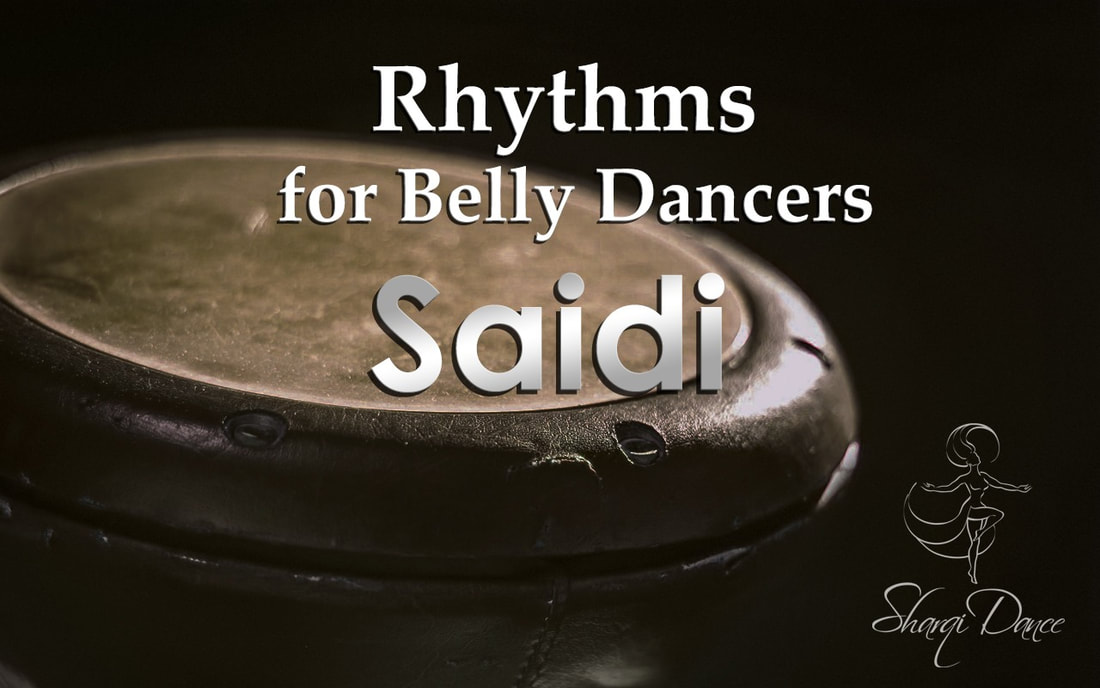|
Learn to identify Saidi rhythm within and outside of Saidi music Saidi is one of the most popular 4/4 rhythms in belly dance music. The "skeleton" of the Saidi rhythm normally has a down beat ("doum" sound) on the 1, and two down beats in the middle (one falling between 2 and 3, and one on the 3): There are some variations of this rhythm that start with an up beat or silence instead of the down beat ("doum"), and there are also variations where there are 3 or even 4 "doums" in the middle! To avoid confusion, let's just stick with this more common variation of the Saidi rhythm for this post, and we can come back to other variations in later posts. Hear this version of the Saidi rhythm as the base rhythm in a drum solo: The word Saidi (صعيدى, sometimes spelled Sa'idi) means from Upper Egypt. The Said, (Upper Egypt) is a region in the south of Egypt. It's called Upper Egypt because it has a higher elevation than the north of Egypt (Lower Egypt), which is closer to sea level. Fun fact: the Nile river flows to the north for that reason! Basically, anything that comes from Upper Egypt could be referred to as Saidi: clothing, food, music, dances, people... anything! In the context of belly dance or Middle Eastern music, when we talk about Saidi we are usually either referring to the music or dances from the Saidi region, or to the Saidi rhythm. Saidi Rhythm =/= Saidi Music? The name of this rhythm seems to indicate it's a rhythm from Upper Egypt, and it is an extremely common rhythm in Saidi music, but it's important to know that this rhythm is not exclusive to the Saidi region! Saidi rhythm is actually super common in Middle Eastern music across genres, including classical, baladi, shaabi, pop, drum solos, and folkloric. And you will find it across the borders of the Arab world, even in music from Lebanon and Syria for example. So while it might be tempting to assume that you are listening to Saidi music when you hear the Saidi rhythm, that isn't always the case. We also can't assume Saidi music will only feature this rhythm we call Saidi, although it primarily does. When you hear Saidi music you might also encounter other rhythms such as baladi, maqsum, malfuf, or fellahi. Here's an example of a famous Saidi song which does feature Saidi rhythm: Baladna (as played by Upper Egypt Ensemble) Here's an example of Saidi rhythm in a composition that is not Saidi: Warda (from 1:11 until 1:49) Here's another example of a Saidi song with Saidi rhythm, this time with dancing! Vanessa of Cairo dances to Sallam Allay There is so much left to be said about Saidi music and dance, so for now I will leave you with these examples. Pay attention to the rhythm in these examples, try to count it out, sing out the "doums" and the "teks" to help you identify the down beats and the up beats in this rhythm. In our next post we will discuss Saidi music and dance, and how you can learn to dance to Saidi rhythm in the specific context of Saidi music. Was This Post Helpful?Was this post helpful? Would you like to learn more about Middle Eastern music and dance? Hit "like" below and leave a comment with your feedback! You can also visit our blog map to find more posts like this, or subscribe to our newsletter, YouTube channel, or Facebook page to be the first to find out about our next post. Happy learning, and happy dancing!
0 Comments
Leave a Reply. |
AuthorYamê is a Brazilian-American View Posts By CategoryIf you'd like to read more articles by Yamê or SharqiDance's guest authors, please view our blog map here.
Archives
January 2024
|




 RSS Feed
RSS Feed